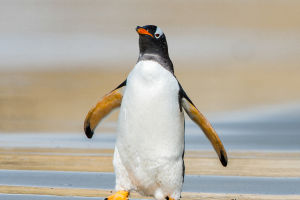The lion, often hailed as the "King of the Grasslands," is an awe-inspiring beast that captures the imagination and commands respect.
Primarily found in the savannas of Africa, lions once roamed parts of Asia, highlighting their historical range and dominance.
Unlike many other big cats, lions are highly social animals, typically living in groups known as "prides." A pride usually consists of several female lions, one or two adult males, and their cubs.
This social structure enhances their ability to hunt and reproduce and strengthens their capacity to defend their territories on the African plains.
Male lions are distinguished by their majestic manes, a feature that serves as a symbol of their identity and plays a crucial role in attracting female lions. The color and density of a male lion's mane are often indicative of his health, strength, and reproductive fitness.
Within a pride, the primary role of the male lion is to protect the territory and its members from external threats, such as rival males or other predators. The lionesses, on the other hand, are responsible for hunting and rearing the cubs.
Female lions are exceptionally skilled hunters, often working in groups to take down large herbivores such as antelopes, zebras, and wildebeests. Their success in hunting is largely due to their ability to cooperate tacitly and execute precise strategies, ensuring a higher probability of capturing prey.
The hunting methods of lions are a testament to their remarkable speed and strength. Typically, lions will stealthily stalk their prey, using the tall grass as cover, before launching a sudden, explosive attack.
Despite their ability to run at incredible speeds, lions cannot maintain these high speeds for extended periods. Therefore, they rely on the element of surprise and close-range ambush tactics to secure their prey.
This hunting strategy is one of the reasons lions hunt in groups; cooperation and division of labor significantly increase the chances of a successful hunt.
The growth and development of lion cubs within a pride are critical to the survival of the species. Newborn cubs usually spend the first few weeks of their lives in a secluded den, hidden among grass or rocks, safe from the threat of predators.
During this vulnerable period, the lionesses take turns caring for the cubs, ensuring they are well-fed, safe, and protected from harm. As the cubs grow and reach two or three months of age, they begin to accompany the pride, gradually learning the skills necessary for hunting and survival.
By the time they are about two years old, male cubs are typically expelled from the pride, forcing them to live independently or seek out a new pride. Female cubs, however, usually remain in their natal pride, continuing the cycle of life within the same group.
Despite the majesty and glory often associated with lions, they face significant survival challenges. Over the past few decades, lion populations have declined dramatically due to factors such as habitat loss, a decrease in prey availability, and illegal hunting by humans.
According to recent statistics, the current population of wild lions has dwindled to approximately 20,000 individuals, a stark contrast to their once-thriving numbers.
In response to this alarming decline, many African countries and international organizations have launched conservation efforts aimed at protecting lions and their habitats.
These initiatives include establishing nature reserves, strengthening legal protections, and raising public awareness about the importance of lion conservation.
Throughout history and across cultures, the lion has been revered as a symbol of strength, courage, and dominance. From the statues of ancient Egypt to the heraldry of medieval Europe, lions have been imbued with significant meaning, embodying both ferocity and nobility.
Even today, the lion remains a potent symbol for many nations, including England and Ethiopia, and is prominently featured in the logos of numerous sports teams and brands.
Despite their numerous challenges, lions continue to be one of the most awe-inspiring creatures in the natural world. They are not only an integral part of the African savannas but also a vital component of human cultural heritage.
With continued conservation efforts, there is hope that these kings of the grasslands will continue to roam the vast African landscapes, maintaining their status as enduring legends of nature.


